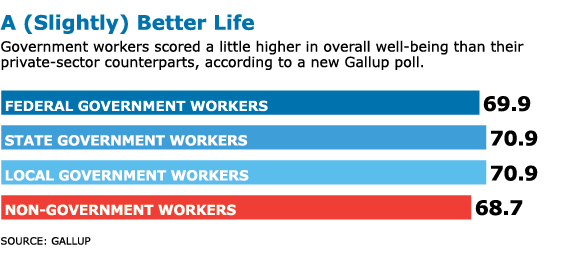Government workers say they're more content -- except in the workplace
Public sector employees scored slightly higher than private-sector counterparts on overall well-being in a new Gallup poll.
There will forever be debate between public- and private-sector employees about who's got the better gig: Private-sector employees say government workers get too-generous benefits; government workers say their private counterparts make more money. But who's happier?
Well, it's close, but public workers scored just slightly higher on their overall well-being scores, according to a new Gallup well-being survey . State and local government workers scored a 70.9 on their overall well-being, with federal workers and non-government workers scoring 69.9 and 68.7, respectively.
The gap widens, however, on individual measures, with government employees proving more content than their private counterparts with their emotional health, physical health, healthy behaviors and access to the basics , such as clean water, medicine and affordable fruits and vegetables.
On how they rate their work environment, federal employees scored a 42.2, while their state and local government and non-government counterparts scored between 47.8 (local government) and 48.7 (non government).

Why are federal employees less happy at work? They get no respect: 50.8 percent of federal workers feel their supervisor treats them as a partner, almost 7 points lower than non-government workers. State workers fared the best, with 58 percent saying their supervisor treated them like a partner. Federal employees also scored lower when asked whether they felt they used their strengths at work and whether they had an open and trusting environment.
Gallup's conclusion: "For leaders of federal agencies, therefore, encouraging partnerships between managers and employees represents a key opportunity area for improving their labor force's wellbeing."
The survey is based 183,992 telephone interviews with working national adults aged 18 and older conducted from January 2 through December 30, 2010. The interviews conducted were part of the Gallup-Healthways Well-Being Index . There is a 95 percent confidence interval that the margin of sampling error is ±0.2 percentage points, thought he maximum sampling error for government employee groups is about ±1 percentage point. The survey includes 7,486 federal employee, 14,132 state employee, and 11,153 local employee respondents in the sample. Active duty military personnel were excluded from the definition of federal employees.






